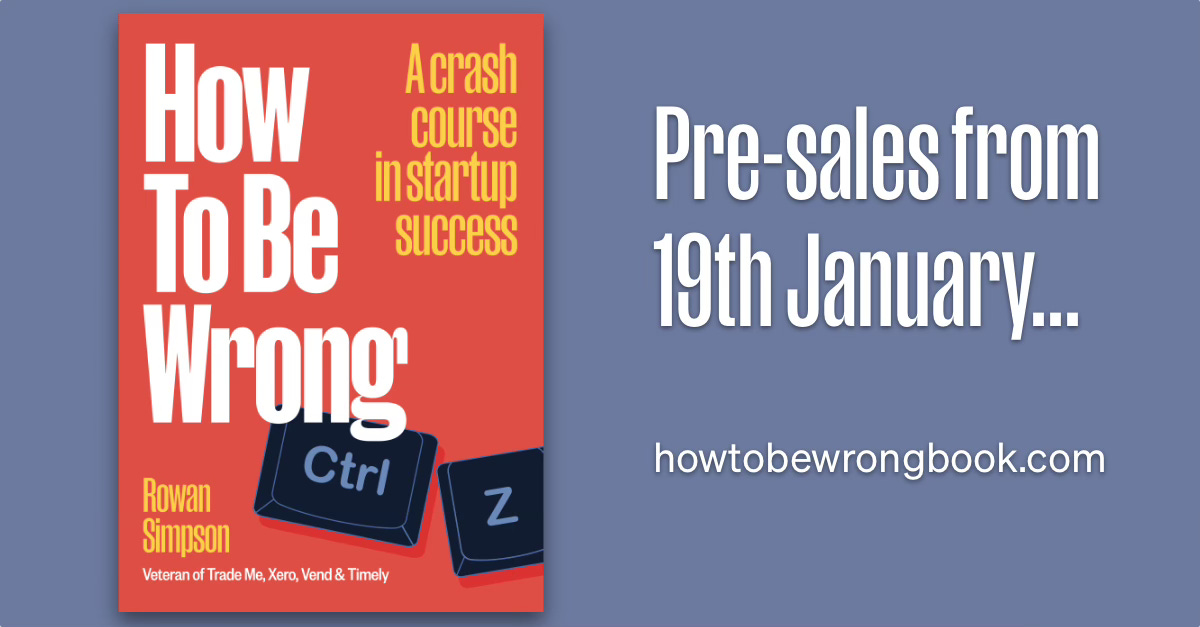Aim ... Fire
Top Three Summer Series - Part 1
Welcome to the 2024/25 Top Three Summer Series. This is the first of six short posts to be published through December and January, leading up to the launch of my new book How To Be Wrong in early 2025. Enjoy!
With the end of the year rapidly approaching and the start of a new year beckoning, it’s a good time to think ahead and make some plans for the future.
Any good plan has three important elements:
Location
Destination
Route
Think of a set of directions in Google Maps… from here to there: 1
The Location is marked with a white dot. The Destination is marked with a red flag. And the Route is described by the blue line/s (with attached estimate of duration to show why one is preferable to the other).
It’s surprising how often we skip at least one of these elements when we’re making our own plans, especially when we’re part of a team or group.
To kick off this Summer Series let’s talk about Location and Destination. We’ll pick up on Route next week…
🪨 Grounded
The first job, before we even think about where we want to go, is to be honest about where we currently are.
Here are two great questions that can help to cut through all of the lies we tell ourselves and others about how things are actually going. Imagine you’re catching up with an old friend or family member you haven’t seen for a while…
What’s the first thing you want to tell them about yourself?
What’s the last thing you want to tell them about yourself?
The second question probably reveals more than the first - it’s always the uncomfortable truths that help to shine a light on how things are really going.
The first response is likely our well-rehearsed highlights reel: our fancy sounding job title, our new prestigious address, our most recent holiday destination etc. Those things might all be true (hopefully they are) but they’re also carefully selected to present our shiny exterior in its best light.
The things you desperately hope won’t come up in conversation? That’s probably closer to the real “location” you need when thinking about what you want to do next. Maybe it’s an important relationship slowly disintegrating, or a career move you’ve been putting off, or a mounting debt, or a health issue you have ignored for too long. For a team, perhaps it's the technical debt that's slowing down every release but keeps getting pushed to “next quarter”, or the declining employee engagement scores that get rationalised away for different reasons, or the customer complaints about a core product feature that everyone has learned to work around rather than fix.
It’s very difficult to make useful plans for the future unless we are honest about where we’re starting from.
🌟 North Star
The second job is deciding where we’d like to go, eventually.
I’ve recently noticed a growing number of founders talking about their “North Star”.
This idea was first coined by investor Sean Ellis in 2017:2
The North Star Metric is the single metric that best captures the core value that your product delivers to customers. Optimizing your efforts to grow this metric is key to driving sustainable growth across your full customer base.
To be clear, I love this idea, but perhaps those of us living in New Zealand and Australia could come up with our own hemisphere-appropriate metaphor - maybe a star that is actually visible from here?!
The companies Ellis referenced in his original article were Airbnb, who used “nights booked”, and Facebook, who used “daily active users”. I’ve also written previously about how “unique sellers” was an orienting metric for us in the early days of Trade Me. I’ve learned that fixating on a single measure can often quickly identify improvements and ensures that everybody on the team is focussed on the same priority.
But we need to be careful about choosing the right star. As I’m typing this I’m watching a bunch of moths repeatedly fly into a light bulb. They all apparently think it’s the moon, and seem to take some convincing otherwise.3
⏲️ %WR Pace
There are three ways to describe a goal:4
Outcome - the result we’d like to achieve
Performance - the effort required to achieve that result
Process - the specific things we’ll need to do over and over to deliver that performance
It’s amazing how often, when we articulate goals, we describe the outcome without any consideration of the performance or process required to produce that outcome.
For example, this week I was sent a working group report that contained the following aspirational goal:
Aotearoa New Zealand is globally recognised as a world leading startup ecosystem for sustainable value creation.
I’ve been working on and investing in startups for more than 20 years now, and I don’t really know what that means.
Who maintains this global leaderboard of startup ecosystems? And how is that ranking determined? Even if that ranking exists - let’s suspend disbelief - what would it actually take for New Zealand to be ranked #1? Finally, if we’re going to lead the world, where are they all going to follow us to?
It’s wonderful to have an audacious vision and describe an outcome, but process goals have a much bigger effect on results.5
A few years ago I had the opportunity to spend a morning training with some Olympic rowers on Lake Karapiro in the Waikato.
To be more specific, they were training, and I was sitting in the boat with their coach.
Elite athletes are measured constantly. There is nowhere to hide. Their performance, and the processes they use to deliver those results are constantly front-of-mind.
I was interested to see the different live metrics that the coach was using to track performance. One in particular jumped out: %WR Pace - i.e. their current pace as a percentage of the world record. They all understood and agreed in advance what speed they would need to produce in a race in order to be the fastest in the world, and they were constantly measuring themselves in training against that benchmark.
What is the %WR Pace for a startup ecosystem? And how do we currently measure up? What are the specific things we’d need to do differently, and eventually learn to do instinctively and repeatedly, in order to perform sustainably at that level?
Please tell me we have some better ideas than tax breaks and government subsidies.
When we look at the contrast between vague aspirations ("world-leading ecosystem") and concrete metrics (“world record pace”), we start to understand why so many of our plans fall short. It's not just about having big dreams – it's about being brutally honest about where we're starting from and defining success in ways we can actually measure and pursue.
This is the fascinating paradox: the route to achieving ambitious goals often starts with admitting what isn't working. Those uncomfortable truths we'd rather not share with old friends? They're not just embarrassing details – they're crucial indicators. When rowers compare their pace in real-time, they're not just tracking speed – they're constantly confronting the gap between where they are and where they need to be.
This willingness to face our current reality, to measure it precisely, and to be wrong about our initial assumptions – that's what separates effective planning from wishful thinking. It's why some people can transform ambitious visions into measurable progress, while others remain stuck in the comfortable haze of impressive-sounding goals.
Next week, we'll ask how to plot the actual route between a current location and desired destination. But for now, take a moment to consider: what are the “North Star” metrics you are currently obsessing over? And more importantly, which ones are you avoiding? If you’re willing to share, I’d love to hear in the comments.
How To Be Wrong will be published in early 2025. Pre-sales are available at https://howtobewrongbook.com
If you know somebody who would find these posts useful please share it with them using the link below…
Or, from Heretaunga to The Reiki Studio in Ohariu Valley, as the case may be.
See: Why are moths attracted to light?, How Stuff Works
See: Three Types of Goals, Peak Performance Center
See: The performance and psychological effects of goal setting in sport: A systematic review and meta-analysis, International Review of Sport and Exercise Psychology





To mangle Confucius, the best time to set and measure progress towards a North Star is 20 years ago; the next best time is today; and perhaps the most memorable time to do so is when you absolutely have to take control of your life or else lose everything.